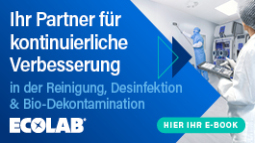Anuga FoodTec: Innovative solutions for the food industry
The example of cleanroom technology: room-in-room concepts ensure longer shelf lives and fresh products
At the upcoming Anuga FoodTec event taking place from 24.3. to 27.3.2015 in Cologne, the international supplier trade fair is exhibiting innovative solutions for the food and drinks industry – from the initial processing steps through to complex technological workflows. This will be exemplified by the example of cleanroom technology. The suppliers already registered for this area include Anton Hurtz GmbH & Co. KG, B-Hygienic - PolySto bvba, BLU Ewelina Kasprzyk, Dastex Reinraumzubehör GmbH & Co. KG, Ecolab Europe GmbH, Endress + Hauser Messtechnik GmbH + Co. KG, FF Fischer Planning LTD., FIMINOX SPA, Friedrich Sailer GmbH, Fromfroid SA, Heraeus Noblelight GmbH, Index-6 Ltd., Maschinenbau Helmers GmbH, Niebling Techn. Bürsten GmbH mrca GmbH, Peschl Ultraviolet GmbH, PNR Deutschland GmbH, Industriespritzdrüsen, SPX Flow Technology, TRAVAGLINI S.P.A., Vikan A/S and Wiedemann GmbH. They are exhibiting in the 'Food Safety/Hygiene Technology' offer sector of Anuga FoodTec. The overarching theme here will be product-specific cleanroom concepts. Since the trend is moving away from large cleanrooms to small, local solutions.
When the catchword 'cleanroom' comes up, most people think of the large halls in microchip factories. However, production under cleanroom conditions, for a long time the domain of the semiconductor branch, is increasingly finding its way into the food industry. Yogurt, bread, sausage, cheese, salads and drinks – more and more products are being filled and packed in sterile environments.
Foods use this to advertise that they do not contain additives. So-called 'clean label' products are in line with the trend. It is the unpopular preservatives that are being cut from the recipes more than anything. 'Less chemistry, more physics', is the philosophy that Martin Schüring from the Bremerhaven Institute for Food Technology and Bioprocess Engineering (BILB) is using to make this point. However, the manager of the F&E Innovation department knows there is another side to this coin: "By shying away from preservatives, food manufacturers have to keep microbiological threats at a greater distance from the product, in order to achieve the desired shelf life."
Less germs in the air
A clean - that means sterile - environment is the prerequisite for being able to relinquish preservatives. Every germ counts! Especially when it comes to fresh products such as salads, pasta, or sandwiches. Schüring: "Cleanrooms can securely lock out bacteria and mould, the factors that cause food to spoil prematurely." And in the truest sense of the word, since multi-level high-efficiency particulate air filters block out even the most miniscule particles. A constant inlet of sterile air generates high pressure, which forces the impure air out of the production zone. The ISO 14644-1 standard is essential. It defines cleanroom classes 1 to 9 and determines how many particles of which size are allowed per one cubic meter of air – the lower the clean room class, the greater the level of purity.
Whilst a chip factory requires a very high level of purity, cleanrooms between ISO class 5 and 8 are the norm for food manufacture. It isn't always necessary to furnish complete production halls as clean rooms, which make a large dent in the budget. ISO class 5 already represents a load of less than one germ per cubic meter, in other words - practically sterile. Schüring: "This is already being put to use in cleanrooms and room-in-room concepts." Clever divisions make it possible to set up zones in the production area with different grades of purity. The highest level of purity is only used where it is really necessary. Like in the production of sliced bread: Laminar Flow Tunnels come into operation for this process. The boxes, which, are sealed on three sides, generate a horizontal or vertical stream of pure air to provide the necessary high pressure. Once the baked goods have been removed from the oven, they are cooled using sterile air and cut whilst still in the tunnel. They only leave the local cleanroom once they have been packed.
Hygiene Minis for the filling process
Every cubic centimetre of pure air is expensive. The aim of the plant construction firm is therefore to configure this on as small a scale as possible. Machines that might be impure are kept outside of this sterile zone. The drinks industry in particular has tried to reduce the cleanroom to an absolute minimum over the years. Restricted Access Barriers (RABS) and isolators are the focus of current developments. The compact 'Hygiene Minis' are not only cheaper to build, but also to operate. The area around an isolator is so strictly marked out that employees are allowed to wear normal hygiene clothing. In modern, cold aseptic filling facilities, only the bottle track still runs inside the isolator, which is separated from the surroundings to form a thick chamber. In this process, non-heated fruit juice flows directly into the bottles. RABS, on the other hand, are not hermetically sealed: An air barrier is generated from the high-pressure inside the housing and protects the heart of the machine – the sterile area. While production is taking place, it can only be accessed from the outside using glove boxes. These are placed at critical points along the filling machine. All other areas can be reached via external doors without air locks.
Organic cultivation in 'pure culture'
The Japanese technology group Fujitsu goes one step further as part of its 'Kirei Yasai' (clean vegetables) programme. Salads are being cultivated on 2,000 m² under cleanroom conditions in a former semiconductor plant. Perfect environmental control means the harvested salad should remain fresh for two weeks at 10 degrees Celsius and display low levels of nitrate. Organic cultivation in 'pure culture' – a new aspect of cleanroom technology.
Koelnmesse GmbH
50532 Köln
Germany








